| Author |
 Topic Topic  |
|
|
Stargazer 40
    
USA
431 Posts |
 Posted - 09/11/2018 : 12:06:07 Posted - 09/11/2018 : 12:06:07


|
I have been pretty amazed at what I've learned over little more than a month with my 500+. Key in my evaluation is some excellent data that has been shared here by GQ and of course ullix and ikerrg. ikerrg is working on a switch addition to the 500+ to remove the M4011 tube from the HV power supply so that we can use the SI3BG tube for much higher activity. GQ has modified the 500+ firmware so that we can record and process information for either one of the two tubes. We also know from recent ZLM video that the PS on the 500+ can support the LND 7317 pancake tube. This provides alpha capture as well as beta and gamma.
I have looked over all other offerings available to me for a similar tube that is less expensive. And I wanted to stay with LND product because I can actually call someone there if I have a problem. Further made in USA says I may not have issues with clone tubes. The tube I arrived at to try to install capability for in my 500+ is the LND 712 in a wand configuration. This is a short tube about 0.6" in diameter and 1.6" inches long compared to the pancake 2" diameter 7317 LND tube. Another reason I went to the 712 is that the mica alpha window while smaller, is much less sensitive to atmospheric pressure changes compared to 7317 (altitude limit 8000').
Image Insert:
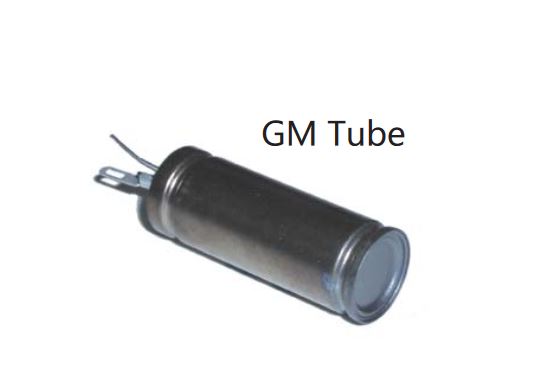
10837 bytes
The important similarity with the 7317 is that it will work well with 500+ power supply. Max Starting V is 325V, Range is 450-650V, and Recommended Working V is 500V.
I also wanted a tube that was easily removable from the 500+. I like the idea of a wand and cable. I found this 712 wand with anode resistor installed at the tube and a 3 pin din connector that would mate with its counterpart in the 500+ case.
Image Insert:

26930 bytes
In order to use this I will need to modify to turn off M4011 tube as ikerrg will show us, and then find a place to insert the din connector in the case. While probably of similar sensitivity to M4011, the slope is only 6% per 100V, and the alpha window appears quite sensitive. Looking forward to taking you all through this effort. |
Stargazer 40 |
Edited by - Stargazer 40 on 09/25/2018 10:56:10
|
|
| Reply #1
ikerrg
    
United Kingdom
334 Posts |
|
| Reply #2
Stargazer 40
    
USA
431 Posts |
 Posted - 09/14/2018 : 07:02:16 Posted - 09/14/2018 : 07:02:16


|
| After some thought I think it better to try and modify a 500 to use this wand and other tubes with a din connector rather than work through the added complexity of the 500+. Will follow up with that. |
Stargazer 40 |
Edited by - Stargazer 40 on 09/14/2018 08:38:00 |
 |
|
| Reply #3
Stargazer 40
    
USA
431 Posts |
 Posted - 09/25/2018 : 10:41:34 Posted - 09/25/2018 : 10:41:34


|
Since I acquired the 500+V2 I am now back to getting the LND 712 wand connected to my original 500+. Tied into the power supply ahead of the anode resistor in series with the SI3BG tube as the 712 wand comes with 10MOhm anode resistor installed at the tube in the wand. Voltage set at 460VDC which may be a little light, but it works as expected. Now will make plug more permanent and then calibrate when time.
Image Insert:
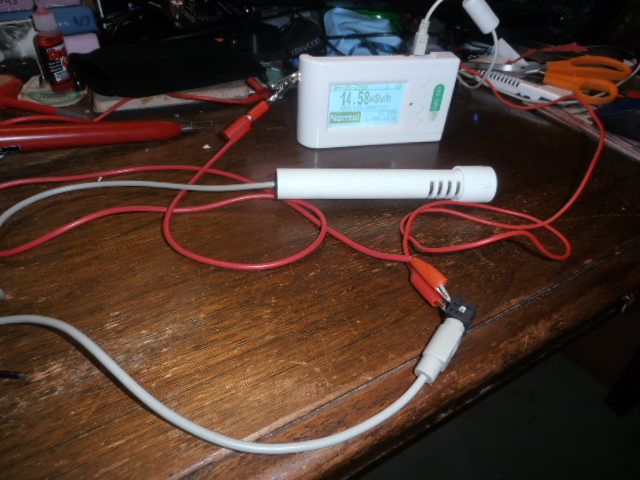
73533 bytes
This tube is an end window mica alpha detector and the wand has a removable cap and beta window along the side. |
Stargazer 40 |
 |
|
| Reply #4
ikerrg
    
United Kingdom
334 Posts |
 Posted - 09/25/2018 : 23:52:22 Posted - 09/25/2018 : 23:52:22


|
| This is actually a beautiful mod, that adds flexibility to the 500+. Now you have to do the more complicated thing: add a connector tho the 500+ case that looks neat. I stopped my mod to add a hardware switch to the 500+ because I am waiting for the 500+ V2 board, but you have two complete 500+ devices, so you can start modding the old one. |
 |
|
| Reply #5
Stargazer 40
    
USA
431 Posts |
 Posted - 09/26/2018 : 03:48:50 Posted - 09/26/2018 : 03:48:50


|
I quite agree on the challenge of cutting a nice looking hole. As EmfDef has suggested I will use a glue gun to affix the female PCB plug to the PCB. It should fit between the clip for the SI3BG tube and the post for the case screw. The plug will come out the back as the size of the component preclude having it come out the side. I may need to modify plastic parts with a little sanding. Only two connections so can clip off other two PCB solder connectors. Probably drill four corners and Dremmel between. We'll move slowly as I agree it really needs to look nice.
|
Stargazer 40 |
Edited by - Stargazer 40 on 09/26/2018 04:49:47 |
 |
|
| Reply #6
Stargazer 40
    
USA
431 Posts |
 Posted - 10/15/2018 : 06:36:18 Posted - 10/15/2018 : 06:36:18


|
Finally got back to this. Attached female DIN connector to power supply near second tube and removed both tubes.
Image Insert:
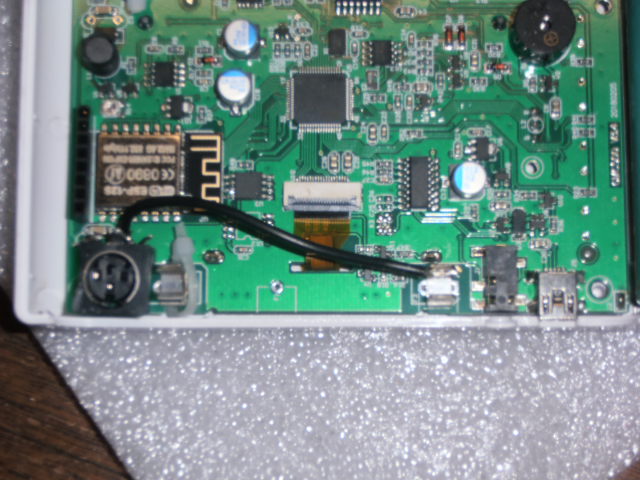
82732 bytes
Cut hole in back of case with Dremel and drill bit.
Image Insert:
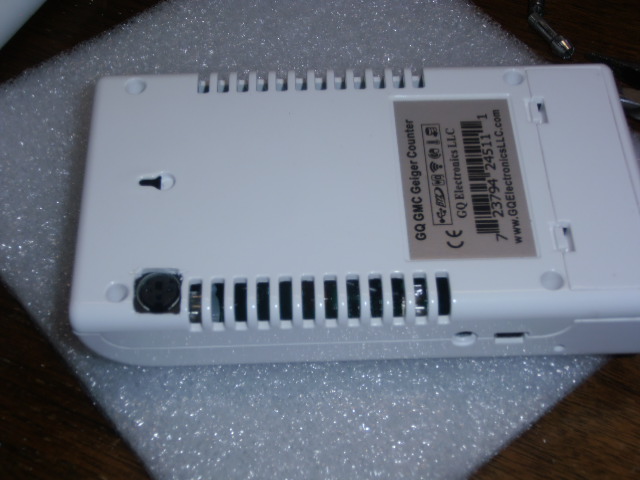
78963 bytes
Set voltage to 500 VDC (recommended by LND)and buttoned it up. Attached wand and turned it on.
Image Insert:
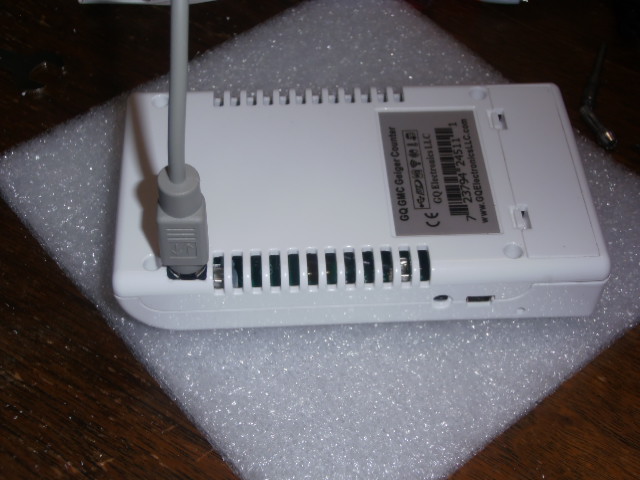
78639 bytes
Image Insert:

81882 bytes
Set the conversion to 108CPM/uSv/hr from LND spec sheet. Used 200CPM = 1.85 uSv/hr for 3rd Calibration point. Displayed tube and tube2 counts. |
Stargazer 40 |
Edited by - Stargazer 40 on 10/15/2018 07:12:41 |
 |
|
| Reply #7
ikerrg
    
United Kingdom
334 Posts |
 Posted - 10/15/2018 : 08:39:58 Posted - 10/15/2018 : 08:39:58


|
Wow! That looks nice! That is a great piece of work, Stargazer_40. How did you fix the DIN connector to the PCB so it does not move or detach when connecting and disconnecting the wand?
Looking forward to seeing some higher field measurements. That LND sensor is almost as sensitive as the M4011, isn't it? 0.00925 uSv/hr/CPM vs 0.0065 uSv/hr/CPM. But I suppose that if it can also detect alpha radiation, any conversion to uSv/h is a very rough guess, even more than for beta and gamma. In any case, it is an amazing mod!
|
 |
|
| Reply #8
Stargazer 40
    
USA
431 Posts |
 Posted - 10/15/2018 : 11:29:55 Posted - 10/15/2018 : 11:29:55


|
I wound up using a small square of 3M double sided tape to hold to PCB. The height of the female DIN PCB connector was really perfect for the space between the inside of the back of the case and the PCB and the connector was larger than the hole cut so it didn't need much to hold in place. And it will make using other wand-like detectors that fit the power supply of the 500+V1 easier to connect.
The tube seems less sensitive to me than what the correction factors show. So maybe the M4011 is more sensitive than indicated in Alchemy2's measure. I will measure both with source in a bit.
|
Stargazer 40 |
Edited by - Stargazer 40 on 10/15/2018 12:01:55 |
 |
|
| Reply #9
Stargazer 40
    
USA
431 Posts |
 Posted - 10/15/2018 : 16:50:17 Posted - 10/15/2018 : 16:50:17


|
Previous Reply #9 has been deleted. Given confusion with DIN pins I actually wired LND tube backward. Still worked, but not very well. That has been corrected and tube matches expectations much better. Will redo numbers with source. Sorry bout that. |
Stargazer 40 |
Edited by - Stargazer 40 on 10/15/2018 16:59:54 |
 |
|
| Reply #10
ZLM
    
1271 Posts |
 Posted - 10/15/2018 : 18:31:44 Posted - 10/15/2018 : 18:31:44


|
@Stargazer 40: Great work! Thanks for sharing.
|
 |
|
| Reply #11
Stargazer 40
    
USA
431 Posts |
 Posted - 10/16/2018 : 04:52:15 Posted - 10/16/2018 : 04:52:15


|
So after rewiring the LND 712 to the correct polarity I left it overnight and was pleased to see with the recommended conversions above that both the V1 with the LND 712 and the V2 with the M4011 showed the same background of .19 uSv/h.
I redid the gamma only measure for each meter and got this for the M4011
Image Insert:
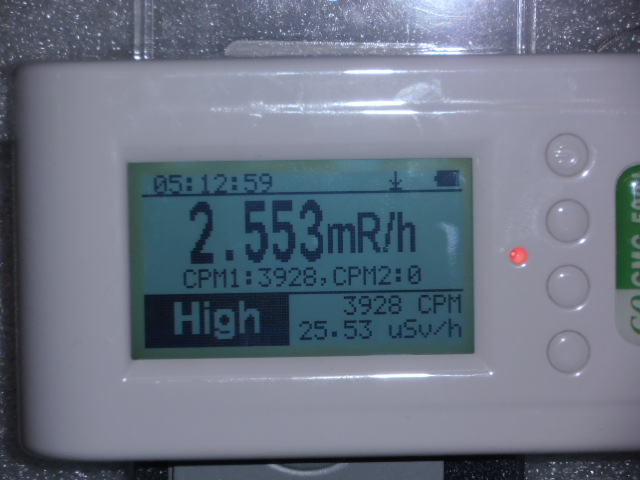
80443 bytes
And this for the LND 712
Image Insert:
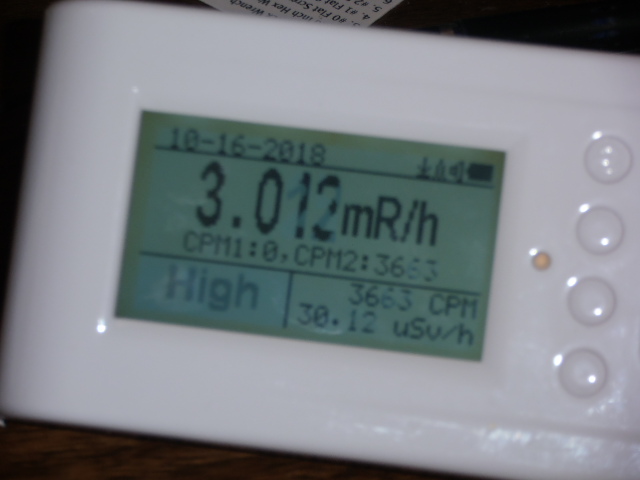
75503 bytes
I also was curious as to just how far this source affects things so had both detectors close to source compared to on it.
Image Insert:
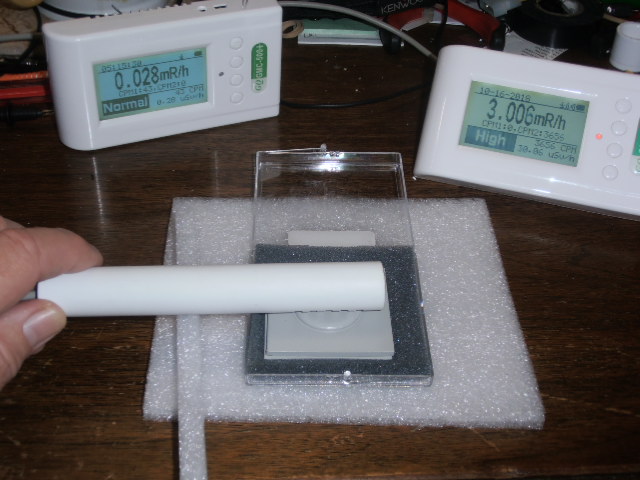
78943 bytes
Here you can see the shielded 5 uCi source is barely increasing counts above background from six inches away.
Now to unshielded M4011
Image Insert:

77415 bytes
and then the LND 712
Image Insert:
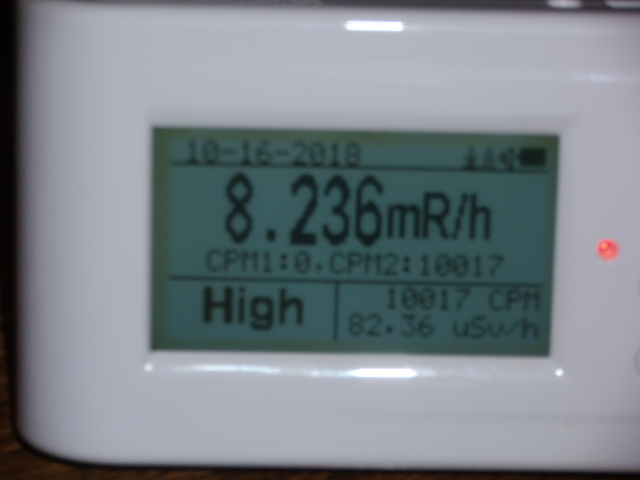
75456 bytes
And now the LND wand on source while V2 6" away
Image Insert:
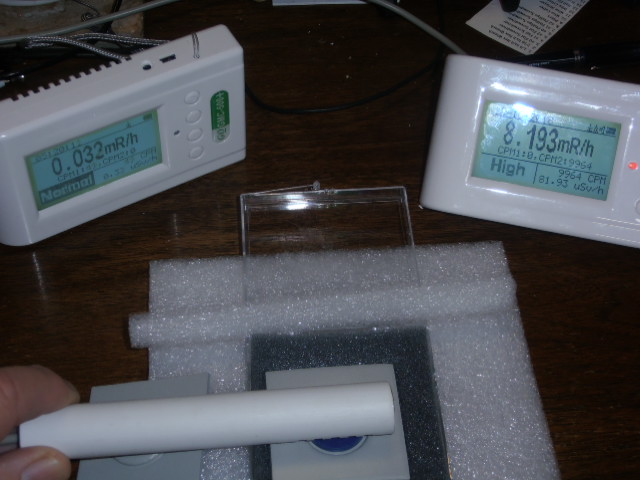
77202 bytes
Again only a little above background.
So for essentially only gammas, the M4011 is showing 25.5 uSv/h and the LND is showing 30.1 uSv/h. They are within 20% of each other. That's actually not bad agreement. I would likely put more credibility on the LND tube, but for high rates, either is in the ballpark.
For the unshielded case the M4011 shows 161 uSv/h while the LND 712 shows roughly half the exposure at 82 uSv/h. So the LND tube is half as sensitive to betas as the M4011 tube. This likely has a lot to do with the stainless steel tube of the LND 712 versus the glass tube of the M4011. And of course the LND is an end mica window tube and can also do alpha particles. Straight on into that end window would likely improve beta sensitivity significantly. That both tubes are in the same ballpark on gammas is the key takeaway here. From a First Responder standpoint, that is what's important. |
Stargazer 40 |
Edited by - Stargazer 40 on 10/16/2018 11:44:39 |
 |
|
| Reply #12
ikerrg
    
United Kingdom
334 Posts |
 Posted - 10/16/2018 : 10:41:24 Posted - 10/16/2018 : 10:41:24


|
Nice! The addition of the hardware switch for the M4011 tube will allow you to have 3 options for the good old 500+V1: High sensitivity with M4011, low sensitivity with the SI-3BG and high sensitivity with the external wand (the SI-3BG in parallel would not be a problem)! You can have all the tubes installed and just connect or disconnect them appropriately. That is a pretty flexible system!
The dead time of this LND tube is quite low. https://www.lndinc.com/products/geiger-mueller-tubes/712-2/. If that is also similar to the M4011 it might explain the high CPM numbers shown by user06. We need a way to make use that dead time in the 500+ firmwares, I cannot repeat it more. Have you seen the official data of the CPS response of the tube? It is asymptotic at 10000 CPS, i.e., 100 microseconds of dead time. Not programming that nonlinearity in the counter just does not make sense to me!
Image Insert:
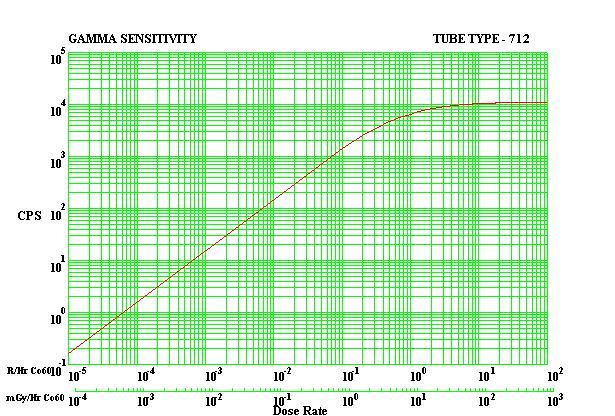
68741 bytes |
Edited by - ikerrg on 10/16/2018 11:00:32 |
 |
|
| Reply #13
Stargazer 40
    
USA
431 Posts |
 Posted - 10/16/2018 : 11:52:35 Posted - 10/16/2018 : 11:52:35


|
| So what switch did you decide on? |
Stargazer 40 |
 |
|
| Reply #14
ikerrg
    
United Kingdom
334 Posts |
 Posted - 10/16/2018 : 14:40:14 Posted - 10/16/2018 : 14:40:14


|
I haven't yet decided. I have had no time to properly think about that. The small switch is perfect for the PCB, but the hole has to be cut on the front of the case, where it is more visible, and it is so tiny that it is difficult to act on. The big switch is easy to fix to the back case but not to the PCB, unless I use a big drop of thermal glue or something like that.
And I still need to borrow a Dremel to do the fine job. So plenty to think and the problem is that I do not have time. In the following days I'll do another plane trip and I will test the new 500+V2 in Heathrow's XRay machine!
What do you think about the confirmation of the nonlinear response of the tube? Don't you think that the 500+ should be capable of defining that curve? (either with more data points or with the dead time and the inverse function)
|
 |
|
| Reply #15
Stargazer 40
    
USA
431 Posts |
 Posted - 10/16/2018 : 15:19:16 Posted - 10/16/2018 : 15:19:16


|
I did want to show the capability of the end window to detect. Here is the 5 uCi source with end window over the center spot
Image Insert:
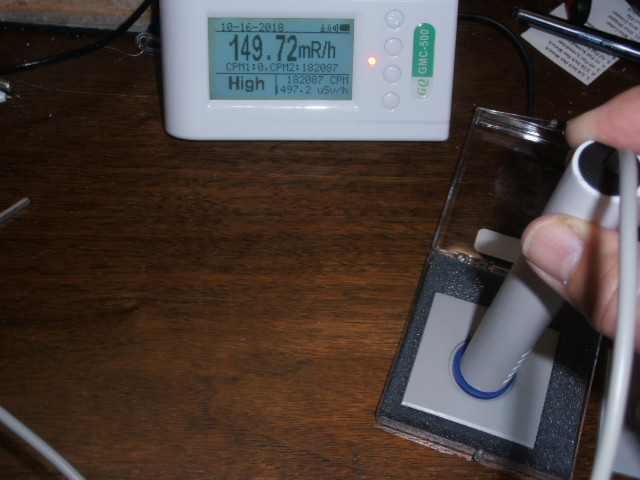
80759 bytes
So very sensitive indeed to betas as well (~182,000CPM, 3033CPS).
ikerrg will think a bit before answering. Given this test, I don't think dead time is only thing to consider. And it is for gamma response. Don't know enough about difference in deadtime for other radiation or different energies. |
Stargazer 40 |
Edited by - Stargazer 40 on 10/16/2018 18:24:13 |
 |
|
| Reply #16
ikerrg
    
United Kingdom
334 Posts |
 Posted - 10/17/2018 : 02:13:20 Posted - 10/17/2018 : 02:13:20


|
As far as I know, the dead time only depends on the time that the tube takes to recover from the previous non-ionised state. It does not matter too much if the avalanche event was created because of an electron or a gamma photon. Therefore, although in the graph it is shown that it is for gamma, that is because any relation between counts and dose rate in these tubes is for gamma, not because the number of counts with beta particles would have a different asymptote (maximum) for the CPS. You can also see that one of the units on the X axis is in Grays, not in Sv.
And in any case, in the 500+ firmwares, what is the purpose of the 2 points for the "calibration" of the M4011 and 1 point for the "calibration" of the SI-3BG? If you want to approximate a curve like the one shown before, you need more points for each tube. I would say that you need one point when it starts being nonlinear (to decide), two points for the elbow and a last point for when the curve starts being linear again and horizontal. I don't know why GQ is not acting on this in any of the many proposed options.
|
 |
|
| Reply #17
ullix
    
Germany
1189 Posts |
 Posted - 10/17/2018 : 04:34:52 Posted - 10/17/2018 : 04:34:52


|
Actually, you only need 2 datapoints: one for the calibration factor, and one for the deadtime. As long as the formula for the deadtime is appropriate, this will suffice.
But of course you need this for each tube!
@Stargazer: since you have already spent some money on this learning endeavor, I suggest to get an oscilloscope to measure the pulse width for your various counters, tubes, and sources. A simple one will do, like this for 90€:
https://www.amazon.de/gp/product/B00SXVUETU/ref=oh_aui_search_detailpage?ie=UTF8&psc=1
You'd need one (better two) 10x probes too, like this:
https://www.amazon.de/gp/product/B01N8TFP8T/ref=oh_aui_search_detailpage?ie=UTF8&psc=1
Then you can use your 1GOhm resistor to measure even the anode voltage.
2 channels is helpful to correlate signals. Pulse generator helpful too for testing. Better scopes are preferred, alas, they are (far) more expensive.
|
 |
|
| Reply #18
ikerrg
    
United Kingdom
334 Posts |
 Posted - 10/17/2018 : 04:58:53 Posted - 10/17/2018 : 04:58:53


|
quote:
Actually, you only need 2 datapoints: one for the calibration factor, and one for the deadtime. As long as the formula for the deadtime is appropriate, this will suffice.
Yes, I know, ullix. I am just trying to avoid more excuses from GQ like “we do not want to mess with the CPM”. By using their own system of “calibration” points, you will get the uncorrected number of CPM on the screen (so you do not touch the CPM), but at least the dose rate in uSv/h will be including the tube nonlinearity behaviour. I know the method with the deadtime and one “calibration” point is better (I did a spreadsheet to implement the full algorithm), but they do not want to use it. What I tried to explain here is that the several point method could be also a decent solution, but it requires more points! It is nonsense to use only 2 points to define that curve for the M4011 and 1 point for the SI-3BG. They are still using the firmware code used in one tube devices, and I cannot understand that. That is just wrong, no matter how you look at it!
|
 |
|
| Reply #19
Stargazer 40
    
USA
431 Posts |
 Posted - 10/17/2018 : 05:21:10 Posted - 10/17/2018 : 05:21:10


|
I agree that the type ionizing radiation is not important, only that the energy level of the particle is capable of initiating a reaction.
I first think we need to look at the basic assumptions and our data. We have LND specs for two tubes that we have data for now - 7317 and 712. As you know the deadtime correction goes to infinity as total deadtime reaches 1 sec. We have to have an acceptable limit for the correction and say that above that the tube is not appropriate for field we're measuring. I would suggest 50% correction is a good number to limit usefulness of the correction to real data. The deadtime for the 7317 is 40 usec. It's max count rate based on deadtime alone is 25,000CPS or 1.5MMCPM. The 712 is a little slower to recover at 90 usec and we see from the graph you posted that it's actually closer to 100 usec. So the 712 max count rate based on deadtime alone (per graph) is 10,000CPS or 600,000CPM.
For the 7317 tube we have ZLM's video showing 201,000 CPM. That's 3,350CPS. Deadtime error is up to just over 15%. A deadtime correction seems likely here, but the voltage shown on ZLM's meter is right above the starting voltage for the 7317 (started out at top of plateau for tube). That may be the real limiter here in using the 7317 with the 500+ V1 power supply. The 15% difference in dose rate using 360CPM/uSv/h from LND specs is 84 uSv/h against a calculated 558uSv/h from conversion of what is read. On my spreadsheets that is one step in about 40 rows. Still a case could be made.
My end window test with the 712 showed 185,000 CPM or 3080CPS. That has a deadtime error of 45%. Much better case can be made here to make use of deadtime correction, but really we are near the limit of what I consider acceptable use of this tube to measure. With sensitivity of 108CPM/uSv/h the difference due to deadtime is 770 uSv/h. This is four rows shift on my spreadsheet, but still not a lot and near the limit of usefulness of this tube.
For the M4011 tube we have been using an estimate of 200 usec deadtime. Its max count rate from that alone is 5,000CPS or 300,000CPM. But now we have seen user06's 500+ meter show 486,000CPM (8,100CPS) summed. I think the SI3BG tube is 123 times less sensitive than the M4011 so the SI3BG tube is only contributing 65.32CPS to the 8,100CPS total. So M4011 is accounting for 8,035CPS or ~482,000CPM. If limited by deadtime we have 125 usec deadtime for the tube as highest possible. BTW, the meter is showing 3,156 uSv/h rate. That comes from 485,538CPM at .0065 conversion, so user06 may be only using tube1? The 65.32CPS for the SI3BG tube is 3,920CPM and if meter is setup to use both tubes, then above 30,000CPM only tube 2 is used. If that were the case the meter should only be showing 760 uSv/h based on GQ's .194 conversion factor. (I think .797 is better and if both tubes are used and only tube2 above 30,000CPM for tube1, then SI3BG reading for 3,920CPM would be 3,124 uSv/h.) So likely only tube1 selected for user06's meter. So for this reading with a reasonable 50% deadtime correction, the tube deadtime would have to be down around 40 usec as well. Where again I think you can make the case to correct, I think as shipped the voltage of the V1 meters is set to around 400VDC. Pretty sure the power supply is limiting counts here and not deadtime. Still if indicated counts are viable at 485,000CPM (and no reason to believe they are not), then the deadtime correction at 100 usec is 420% or 2.5MM counts. That's 4 times more intensity, but is it real?
I think we need to know actual deadtimes better before correcting and then establish some reasonable limits for the correction and range of tube use. All that might simply be too complicated. Perhaps better to simply provide as GQ does the ability to export readings and do spreadsheet conversions.
About the only other thought, is how do labs that certify these meters take into account dead time? I need to call some of them in the US. You might remember when I looked at the calibration of the Civil Defense CD-V 700 meter they didn't seem to take into account the half life of the Ce137 calibration dot on the side of the meter and it was only reading a third of what it should have.
|
Stargazer 40 |
Edited by - Stargazer 40 on 10/17/2018 05:45:00 |
 |
|
| Reply #20
Stargazer 40
    
USA
431 Posts |
 Posted - 10/17/2018 : 05:27:00 Posted - 10/17/2018 : 05:27:00


|
ullix, I have a Heath 4554 dual trace oscilliscope (and probes also). Would need to get familiar with it again as it's been a few years since use.
Image Insert:
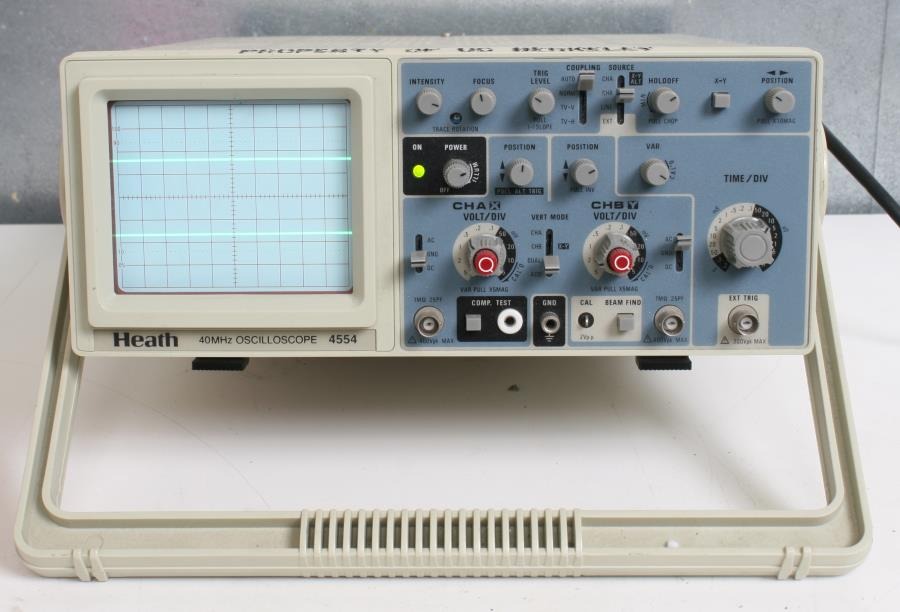
75011 bytes |
Stargazer 40 |
Edited by - Stargazer 40 on 10/17/2018 05:49:54 |
 |
|
| Reply #21
Stargazer 40
    
USA
431 Posts |
 Posted - 10/17/2018 : 06:43:54 Posted - 10/17/2018 : 06:43:54


|
| I called a certification lab in North Carolina. Spoke to the technician. Meters that he sees are providing readouts in uSv/h that are corrected for deadtime estimate by meter firmware for the range that is specified in the certification. For example if the 7317 tube is used and it is to be certified from .01 uSv/h to 1250 uSv/h and has 350CPM per uSv/h then deadcount correction would apply from 3CPM to 437,500CPM. That would require about a 30% correction to meet specs of calibration source. So as far as certification of meters, deadtime is important (and therefore something I would recommend GQ provide the option to input conversion factor and deadtime for calculation (one point plus deadtime)). |
Stargazer 40 |
Edited by - Stargazer 40 on 10/17/2018 08:36:02 |
 |
|
| Reply #22
ikerrg
    
United Kingdom
334 Posts |
 Posted - 10/17/2018 : 08:53:50 Posted - 10/17/2018 : 08:53:50


|
| That makes sense! Thanks for confirming that with an external source, Stargazer 40. Now we only need GQ to read it and want to do the proper changes in the firmwares. As they are at present, the reading error is massive at high count rates. |
 |
|
| Reply #23
EmfDev
    
2314 Posts |
 Posted - 10/17/2018 : 10:30:11 Posted - 10/17/2018 : 10:30:11


|
Thank you guys for your hard work and suggestions. Alright we have decided to try this idea.
Please help us get/confirm these values as you guys have calculated/tested before.
Tube1(m4011) dead time.
Tube2(SI3-BG) dead time.
Formula for calculating the actual CPS/M.
This formula will apply only above the cps threshold AND if the dead time setting is 0 micro seconds.
Default dead time = 0 micro seconds so this will use the current algorithm.
CPS threshold for tube 1 is the CPM in 2nd calibration/60 (default in 500/+ is 30,000/60 = 500CPS).
CPS threshold for tube 2 is CPM/60 in the tube 2 calibration setting.
Calibration factor of tube 1 is Calibration point1 (=uSv/CPM) in calibration settings.
Calibration factor of tube 2 will be the Calibration point3 in settings.
Edit.
Another way is we fix the dead time and let user to select if
we use dead time for calculating cpm at high range. |
Edited by - EmfDev on 10/17/2018 10:41:07 |
 |
|
| Reply #24
Stargazer 40
    
USA
431 Posts |
 Posted - 10/17/2018 : 12:45:07 Posted - 10/17/2018 : 12:45:07


|
Thanks EmfDef. This all looks to work well, but will there be a place we could enter the deadtime for tube1 and tube2, rather than have it hardwired in? I know deadtime from LND specs for 712. I have not found the deadtime anywhere for M4011, but data and the other meter in user06's third picture suggests it could be 103 usec, which gives a ~5 times increase in dose rate from what's calculated (2.88MM CPM). On the SI3BG, I would suggest something like 200 usec as we really have no data.
CPMdt= CPM/(1-(dt*CPM/60))
Don't think we should fix the deadtime unless it is spec'd somewhere. M4011, no. SI3BG, no. SBT-11, no.
This would go hand in hand with the Fast CPM calc addition.
ullix and ikerrg will likely respond tomorrow. That's how I see it. For the other single tube meters, this should be easier, and where we know, like for the 7317 in the 600+, easiest of all. |
Stargazer 40 |
Edited by - Stargazer 40 on 10/17/2018 13:08:18 |
 |
|
| Reply #25
ikerrg
    
United Kingdom
334 Posts |
 Posted - 10/17/2018 : 14:08:42 Posted - 10/17/2018 : 14:08:42


|
@EmfDef: Either way looks OK to me, but with your first option the correction will be active by default if you have set the default dead times for both tubes (which is OK to me, as the readings when it becomes active are very high).
So, to confirm the change, I understand that you plan to correct the CPM/S reading of each tube using the formula:
CPScorrected= CPS/(1-deadtime*CPS)
…only when the CPS is higher than the (calibration point CPM)/60 than AND the deadtime setting is greater than 0 seconds (not equal to 0 seconds as you say in your post). The CPM is still calculated by integrating the CPS in a 60 second window as at present, so it will be automatically corrected or uncorrected depending on the previous algorithm.
Obviously there should be a setting for the dead time in the menu for each tube. If that setting is 0 seconds, the formula does nothing. If it is greater than 0 seconds (e.g. 200 microseconds, i.e. 200e-6 s) it will correct the CPS/M only above the (calibration point CPM)/60.
If you implement this, I suggest you to also increase the default threshold (calibration) for the tube 2 (SI-3BG), i.e. increase the 3rd calibration point to something higher in CPM, like 3600 CPM. At the present 25 CPM the correction will do nothing, and the CPS would be less than 1 (0.4166). It is better if you set something higher so the formula makes a difference and avoids swapping to the formula algorithm when only one count is detected in 1 specific second. There is still controversy for the ratio in the SI-3BG to calculate the uSv/h, but I will use something by default like 0.48 uSv/h/CPM (i.e. 3600 CPM = 1728 uSv/h). The present value of 0.194 is way too low.
Regarding the dead time defaults, I propose to start using 125us for the M4011 (that to my understanding seems to approximately align to user06’s readings), and 200us for the SI-3BG (just because we have no more data and it does not matter so much, as 5000 CPS is a crazy number for the SI-3BG). With the oscilloscope that Stargazer_40 has shown, it should be possible to see under high radiation what happens to the voltage between pulses, and therefore guess a better default value for the dead time of both tubes (at least for the M4011).
At least now we can test the algorithm thanks to Stargazer_40 and his Cs137 sources, so we will be able to know if it is working as expected by doing the right changes in the deadtime settings and CPM thresholds and measuring again.
All this works well for the Tube1 or tube2 modes. Regarding the AUTO mode, you still need to think on how to avoid the sum of both CPS/CPM. I already proposed what to do in the spreadsheet.
I am going to be in a business trip during the following days, so I will not be able to respond quick/at all to the posts.
And in any case, thanks for finally considering this!
|
Edited by - ikerrg on 10/17/2018 14:11:32 |
 |
|
| Reply #26
Stargazer 40
    
USA
431 Posts |
 Posted - 10/17/2018 : 14:32:55 Posted - 10/17/2018 : 14:32:55


|
@ikerrg - I think the average of the high and low range of sensitivity to gamma that you found for SI3BG specs, and that I posted in ullix's 500+ review from specs I found couple days ago is a better number than what you propose. If we have tube specs (even in Russian) then it's a good place to start. The average of the range high and low is .797 conversion factor (1.254 CPM/USv/h). I have no problem with 125 usec for M 4011, although I would start out by changing to lower number (103 usec) 
The formula I entered was for changing CPM to CPMdt. If EmfDef wanted to use CPS formula fine, although are we creating a number (CPSdt or CPMdt) that will be saved in history?
Oh, and I ordered the 10 uCi Cs137 source. I felt it was best to stick with what people that certify these meters work with (Cs137). That will allow me to get some more data on the less sensitive tubes. I got a nice deal on couple of lead cylinder pigs to store in on Ebay. 6mm of lead thickness so total of 20% gamma reduction and blockage of beta completely. Also will get another pair of flat lead plates with 1.125" punch for disks (shipping container) for when using at work table. |
Stargazer 40 |
Edited by - Stargazer 40 on 10/18/2018 04:30:35 |
 |
|
| Reply #27
ikerrg
    
United Kingdom
334 Posts |
 Posted - 10/17/2018 : 14:48:20 Posted - 10/17/2018 : 14:48:20


|
I am currently using 0.48 uSv/h/CPM, based on ullix's measurements with potassium salt. However, I am happy with anything higher than the present default number, so 0.797 looks also OK. You should also be able to measure during long times by shielding your Cs137 source to betas and get the right ratio between M4011 and SI-3BG tubes. That assuming that we totally trust the 0.0065 uSv/h/CPM for the M4011, as we will be using that as the base to calculate the calibration for the SI-3BG.
In history it should be saved only what it is calculated. So corrected counts when the correction is used or measured counts when no correction is used (when under threshold CPS or if the dead time is set to 0). CPS or CPM is the same, the counter always counts CPS, then it saves or shows what it is asked for.
|
Edited by - ikerrg on 10/17/2018 15:08:34 |
 |
|
| Reply #28
Stargazer 40
    
USA
431 Posts |
 Posted - 10/18/2018 : 11:11:03 Posted - 10/18/2018 : 11:11:03


|
If like me you do thought experiments that keep you up at night it may be no surprise that I have been thinking about how we will test this DT correction. I have created spreadsheets that I laminate to put with my meters to show levels of radiation effects. One thing that quickly became apparent is when the Dead Time correction becomes significant for the M4011 tube (greater than 25% using 125usec), the SI3BG tube is still below 1% DT correction. Should be able to hit 300,000 CPM in with the M4011 tube with both the 5uCi and 10uCi sources together and see if the DT correction is viable. That is only about 1500 CPM in the SI3BG tube. It also seems that we can in effect calibrate the conversion factor and the DT between the other tubes as well (712, 7317, SBT-11, SBM-21) by using multiple points of comparison.
So we will get a degree of confirmation that this is viable or simply theory. |
Stargazer 40 |
Edited by - Stargazer 40 on 10/18/2018 11:14:10 |
 |
|
| Reply #29
EmfDev
    
2314 Posts |
 Posted - 10/18/2018 : 16:20:44 Posted - 10/18/2018 : 16:20:44


|
Alright here's some progress.
Testing it
1.66667kHz = 100,000CPM(supposed to be) becomes 124960CPM (TRUE IS 125000) for tube 1 with dead time 120uS(default).
1.66667kHz = 100,000CPM becomes 149960 CPM (TRUE IS 150000) for tube 2 with dead time 200uS(default).
Tube 1 and Tube 2 deads times can be set by the user (from 0 microseconds to 255microseconds).
Dead time usage is enabled by default and there's no threshold.
There's also fast estimate option added.
|
Edited by - EmfDev on 10/18/2018 21:01:11 |
 |
|
| Reply #30
Stargazer 40
    
USA
431 Posts |
 Posted - 10/18/2018 : 19:01:27 Posted - 10/18/2018 : 19:01:27


|
| @EmfDef - are we updating both V1 and V2 500+ with these changes? |
Stargazer 40 |
 |
|
| Reply #31
EmfDev
    
2314 Posts |
 Posted - 10/18/2018 : 20:57:38 Posted - 10/18/2018 : 20:57:38


|
| Yes, but actually wait a little time we still need to finalize the code. |
Edited by - EmfDev on 10/18/2018 21:00:37 |
 |
|
| Reply #32
Stargazer 40
    
USA
431 Posts |
 Posted - 10/19/2018 : 02:32:23 Posted - 10/19/2018 : 02:32:23


|
At some point below the 100% dead time level the corrected CPS numbers get very large. For 120usec dt the 100% number is 8333CPS (500,000 CPM). We need to recognize that if the meter is correcting for dead time there is a limit. For example, user06 recorded ~486,000 CPM. I think this was M4011 tube only. Corrected for 120usec dead time the CPM is just over 17MM CPM (283,333 CPS). That equates to 112 mSv/h, or 35 times the dose rate indicated without the dead time correction. At 8333CPS we divide by zero and with more counts the number goes negative and is invalid. Given user06's described activity, I believe that number is helpful. At or above the 100% dead time the meter needs to somehow inform the user that it no longer is good number. Perhaps a dash or some other indicator. Does that make sense?
And it is helpful to look at how this can guide calibration. My preferred number is 103usec for the M4011 tube. user06's 486,000CPM now shows corrected count of 2.93MM CPM. That equates to dose rate of 19mSv/hr (six times uncorrected dose rate) and is a close match to the dose rate indicated on the other meter in the picture. That meter is a Terra-P, made in Ukraine. According to website it is a commercial version of the military Terra meter used by Ukrainian military. I have inquired of the company if dead time correction is used in the Terra-P. |
Stargazer 40 |
Edited by - Stargazer 40 on 10/19/2018 02:48:55 |
 |
|
| Reply #33
ikerrg
    
United Kingdom
334 Posts |
 Posted - 10/19/2018 : 09:01:23 Posted - 10/19/2018 : 09:01:23


|
| That is a good point Stargazer 40. The code should check that the CPS every second is smaller than 1/deadtime. If it is not, then show overload or nothing, like in a DMM when the voltage is over the selected range. |
 |
|
| Reply #34
Stargazer 40
    
USA
431 Posts |
 Posted - 10/19/2018 : 11:01:45 Posted - 10/19/2018 : 11:01:45


|
quote:
Originally posted by ikerrg
Nice! The addition of the hardware switch for the M4011 tube will allow you to have 3 options for the good old 500+V1: High sensitivity with M4011, low sensitivity with the SI-3BG and high sensitivity with the external wand (the SI-3BG in parallel would not be a problem)! You can have all the tubes installed and just connect or disconnect them appropriately. That is a pretty flexible system!
If I drive the LND 712 at the recommended 500VDC I can leave all three tubes in place. If I drive the LND at the top of the plateau (650VDC) then I need to pull at least the M4011 tube and likely the SIBG3. With the DIN female allowing access to the SI3BG power supply, I will drill a small hole over the pot on the PCB that controls voltage and get another male 3 pin DIN plug to act as connector to DMM to set voltage without taking the back off. |
Stargazer 40 |
 |
|
| Reply #35
EmfDev
    
2314 Posts |
 Posted - 10/19/2018 : 16:03:10 Posted - 10/19/2018 : 16:03:10


|
We decided to not put threshold on the dead time use. If the number becomes negative, it means the dead time being set is wrong AND that can only happen in extreme case. Even user06's reading wouldn't produce negative CPS with 120usec dead time considering he went to a very dangerous place with extreme levels of radiation. Some part of that 480k+ cpm also came from tube 2 and tube 1 might have been saturated. And based from observation and your testing results and our results. We have decided to update the calibration of tube 2(SI-3BG) to be 100x less sensitive than tube 1(M4011) for now. Users are able to edit these values on their own.
From ullix's testing before
http://www.gqelectronicsllc.com/forum/topic.asp?TOPIC_ID=4598
said max CPM of m4011 is 300,000 with dead time of 200us.
But I doubt user06's tube2 got almost 200k count from the picture. |
Edited by - EmfDev on 10/19/2018 16:04:52 |
 |
|
| Reply #36
Stargazer 40
    
USA
431 Posts |
 Posted - 10/19/2018 : 17:28:21 Posted - 10/19/2018 : 17:28:21


|
@EmfDef - I certainly agree that we don't need a dead time threshold. Just the Calibration CPM and uSv/h, and the Tube Dead Time.
And your comment about 'if the number becomes negative ... dead time set is wrong' gets to the calibration. When we get to third party certification of these meters, they will perform calibration with all three of those factors at the levels certified. There should be no real question that for the range certified that the dead time and dose rate calibration is within the bounds stated. All sounds good. |
Stargazer 40 |
 |
|
| Reply #37
ikerrg
    
United Kingdom
334 Posts |
 Posted - 10/21/2018 : 13:23:28 Posted - 10/21/2018 : 13:23:28


|
@EmfDev: Yes, there is no need for the threshold, just if you wanted to not to use the formula at low count rates for the average user. But the formula works well at low count rates, and it does not affect the low readings as it can be seen in the spreadsheet I shared with you. On the other hand, the dead time setting is like any other setting. If it is wrong, nothing makes sense. That is why I think we are in the right path setting it by default to 125-ish for the M4011, and 200-ish for the SI-3BG. The first is likely quite close to the reality after seeing user06 readings, and for the second one, well, nobody is going to see that radiation level ever! (hopefully)
On the other hand, I just downloaded the data measured by the 500+V2 during my last flight (here: https://www.dropbox.com/s/o7bx00t7eq8nlbs/DataFlight.zip?dl=0 ) . I had only the tube 2 activated. Please, check why the numbers around "2018-10-19 09:26 9:26" do not make sense. Then is when I went through security xrays. There is a missing minute and the sum of counts do not match the counts in the minute 9:28! I was not operating the device buttons, in fact I did not operate the device at all during the whole flight, after what happened last time. You shoud check your storage algorithm, something looks wrong!
Anyway, I remember I saw an increase of about 2040 counts on the screen after I passed through security (remember, only the SI-3BG). Those counts during 5 seconds would be equivalent to 24.5 kCPM! That is why the dead time for that tube is not so critical, as it is very unlikely that a radiation can keep that strength for 1 whole minute, and in any case 24.5 kCPM is still almost unaffected by the dead time correction.
|
Edited by - ikerrg on 10/21/2018 13:52:04 |
 |
|
| Reply #38
EmfDev
    
2314 Posts |
 Posted - 10/22/2018 : 09:20:49 Posted - 10/22/2018 : 09:20:49


|
| We've checked the bin file is correct but the parsing seems off. We will check it. |
 |
|
| Reply #39
ikerrg
    
United Kingdom
334 Posts |
 Posted - 10/22/2018 : 09:58:40 Posted - 10/22/2018 : 09:58:40


|
Thanks. I am on a trip and I cannot have access to GeigerLog to open the binary file. I used DataViewer 2.54.
Please keep us updated. |
 |
|
| Reply #40
EmfDev
    
2314 Posts |
 Posted - 10/22/2018 : 11:46:20 Posted - 10/22/2018 : 11:46:20


|
| Yeap. Will let you know. |
 |
|
| Reply #41
Stargazer 40
    
USA
431 Posts |
 Posted - 10/24/2018 : 08:23:53 Posted - 10/24/2018 : 08:23:53


|
| Just a quick add - I got a reply back from the company that makes the Terra-P meter (Lithuania) that user06 was comparing to the GMC500+. They do have dead time compensation incorporated into their dose rate calculation |
Stargazer 40 |
 |
|
| Reply #42
EmfDev
    
2314 Posts |
 Posted - 10/24/2018 : 13:51:20 Posted - 10/24/2018 : 13:51:20


|
| We checked the value of the dead time calculation and it looks close to that user06 picture of Terra-P. |
 |
|
| Reply #43
Stargazer 40
    
USA
431 Posts |
 Posted - 10/24/2018 : 17:08:46 Posted - 10/24/2018 : 17:08:46


|
| It will be interesting to check the dead time corrected M4011 tube with the SI3BG tube when both are compared on a high activity source. If everyone is using the same equation, then it will come down to the calibration against a calibrated source. I have a feeling that given the variation in GM tubes of a particular kind, that the dead time is going to be an important part of the calibration process. |
Stargazer 40 |
 |
|
| Reply #44
ikerrg
    
United Kingdom
334 Posts |
 Posted - 10/25/2018 : 00:15:50 Posted - 10/25/2018 : 00:15:50


|
| So finally the dead time correction is something very common being used by many manufacturers and calibration labs... but it took a long time for GQ to understand that correction process, and to be convinced that they should implement it in their counters. And it is not because I didn't say that many times in the last months. Thanks Stargazer_40 for the research and the confirmation of all that! And thanks GQ for implementing the modifications and adding value to the counters. |
 |
|
| Reply #45
Stargazer 40
    
USA
431 Posts |
 Posted - 10/25/2018 : 04:16:35 Posted - 10/25/2018 : 04:16:35


|
I think the best part of all this is that we continue to evolve a set of firmware (and hardware) that brings more and more flexibility and adaptability to a set of fine products. This isn't happening with anyone else I'm researching. Products are done when released. Access to firmware is limited at best. Ikerrg, you and ullix have done us all a huge benefit by contributing your experience, data and analysis (not forgetting the mike and others, but you two have shown some clear shortcomings that GQ has acted on.
Ahead we need to get to best possible initial settings for out of the box use. Then third party calibration and certification for credibility. I want folks I work with in First Responder world to have access to a solid utility instrument for personal dosimeter tracking in many different conditions. I remain confident GQ is on the right path to accomplish that.
I hopefully will be talking to LND today about their end window and pancake tubes. The end window 712 response to the Cs137 10 uCi source is pretty amazing in the 500+ V1 (voltage set at top of plateau at 650VDC). Oh, and the speaker is silenced at this level as user06 reported occurring.
Image Insert:

80931 bytes
This is compared to gamma response with lead shielding which is quite different.
Image Insert:

80938 bytes
and without, but through the stainless steel tube.
Image Insert:
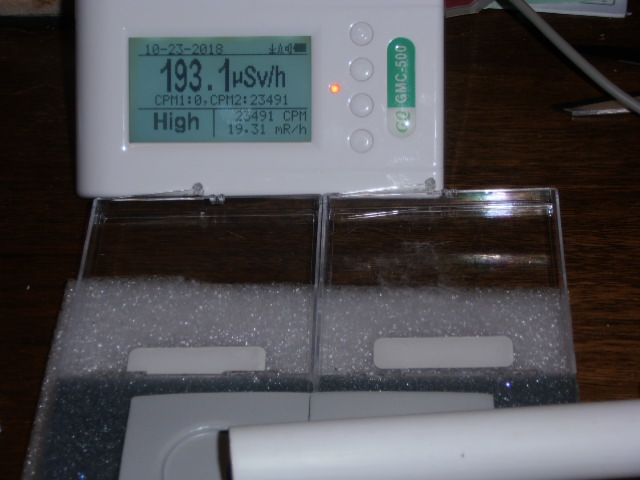
78247 bytes |
Stargazer 40 |
 |
|
| Reply #46
ikerrg
    
United Kingdom
334 Posts |
 Posted - 10/25/2018 : 07:58:01 Posted - 10/25/2018 : 07:58:01


|
| Wow! 300 kCPM! You are going to be able to test the new dead time correction algorithm once it is implemented in the firmware. I am looking forward to seeing the graphs comparing the readings to the theoretically expected counts with and without the algorithm. You are doing a great job, Stargazer_40 (and spending a lot of money in different sources and devices, by the way). |
 |
|
| Reply #47
Stargazer 40
    
USA
431 Posts |
 Posted - 10/25/2018 : 08:46:11 Posted - 10/25/2018 : 08:46:11


|
quote:
Originally posted by ikerrg
Wow! 300 kCPM! You are going to be able to test the new dead time correction algorithm once it is implemented in the firmware. I am looking forward to seeing the graphs comparing the readings to the theoretically expected counts with and without the algorithm. You are doing a great job, Stargazer_40 (and spending a lot of money in different sources and devices, by the way).
I find this all fascinating. And when a company is as responsive and forthcoming at GQ is, there is very timely feedback that adds to maintaining and encouraging additional effort. I am as value conscious as the typical consumer and that is what first convinced me to buy a GQ GM meter. I know quite a bit more now (as we all do), and I remain convinced it was an excellent choice. And dollars, while not trivial, would go toward some other hobby or educational effort. I have to admit that there is a whole new appreciation for things unseen and deadly important here from my perspective.
We haven't looked at alphas with the wand. Here's an Americium 241 source still in its smoke detector frame. Provides about 10mm of standoff from end window detector. Let's first look at the non-alphas by placing a piece of paper over the source.
Image Insert:

80941 bytes
437CPM and 3.59uSv/h. This source is labelled as <.9uCi. It is pretty potent alpha source shown here with paper removed.
Image Insert:

80990 bytes
Over 100 times the CPM at 44,498CPM and 365.9uSv/h. It's not amazing so much as interesting that the typical piece of white printer paper can stop cold these alpha particles. Again though we see the difference in conversion factors for different energies. I'll post here but repeat over in GMC-600 review the results of the SBT-11A alpha test. First with paper blocking alphas - 1.451uSv/h - 508CPM
Image Insert:
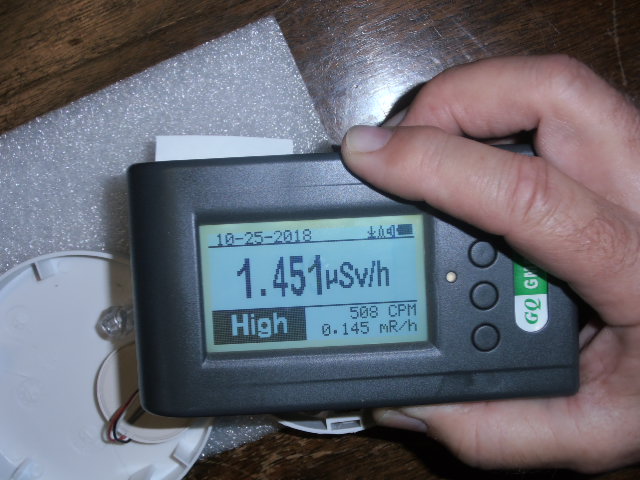
76269 bytes
And then with paper removed - 30,000 CPM - 85.791uSv/h
Image Insert:
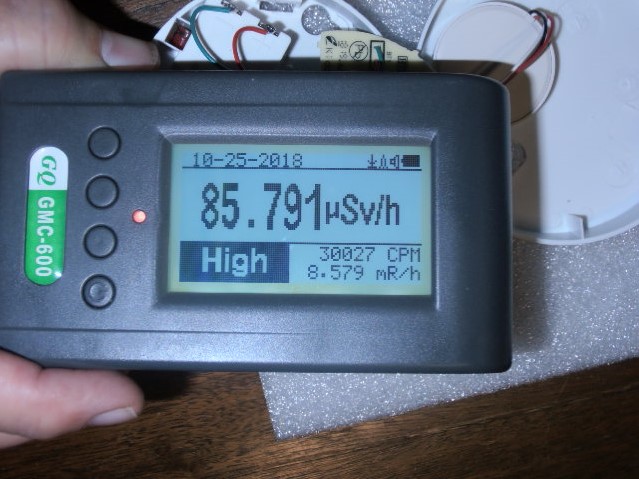
109210 bytes
A little more than half the alpha dose rate of the LND712 tube and 2/3 the CPM. |
Stargazer 40 |
Edited by - Stargazer 40 on 10/25/2018 12:45:41 |
 |
|
| Reply #48
Stargazer 40
    
USA
431 Posts |
 Posted - 10/25/2018 : 09:13:50 Posted - 10/25/2018 : 09:13:50


|
Related to the wand's LND712 GM tube, and nice to get a feel for how directionality affects these end window tubes. I received this chart today from the company. It applies to the side response of the 712 compared to the mica window. As expected, but nice to see differences.
Image Insert:

57128 bytes
The higher response of the side of the tube to higher energy relates to more surface area exposed by a tube longer than its diameter. |
Stargazer 40 |
 |
|
| Reply #49
ullix
    
Germany
1189 Posts |
 Posted - 09/25/2019 : 01:23:56 Posted - 09/25/2019 : 01:23:56


|
@Stargazer: all I could find in this lengthy post with respect to calibration of the LND712 is the one taken from the tube's spec sheet, 108 CPM/µSv/h, or the reverse = 0.009 µSv/h/CPM, that I had referred to. Have I missed other data?
The image in your Reply #48 is quite interesting, but what exactly is it showing? I presume Cs137 gamma response? Cs137 has a strong 666keV gamma, which the LND712 is calibrated against.
Noteworthy is the strong dependence of response on the gamma energy. That property, to my knowledge, is present in all tubes. (Some energy-compensation tricks are sometimes applied to smoothen the response curve; but neither LND712, nor M4011, nor SBM20 is compensated).
It is still not disclosed by GQ or anyone else, against which source the M4011 is calibrated against, let alone that a response curve is published. I speculate in my GeigerLog manual, chapter Calibration, that simply the same value as for the SBM20 was taken.
But even the SBM20 provides only 2 values, one for Co60 (>= 1200keV) and one for Ra226 (~100keV).
So my question remains: what is the response of the LND712 versus the M4011 with repect to radiation, typical Geiger users come across, like background, Uranium (stone, tiles,...), Thorium (gas mantle), K40 (K-salt)?
The image showing that the window is less sensitive than the side (I guess a surface size effect?) and the LND smaller in volume and surface area than the M4011, that the M4011 would be more sensitive for the "average user"?
|
 |
|
| Reply #50
Stargazer 40
    
USA
431 Posts |
 Posted - 09/26/2019 : 03:04:05 Posted - 09/26/2019 : 03:04:05


|
@ullix - I take the conversion factors supplied by LND without question. So 108CPM/uSv/h works for me. Certainly they've tested them. I plug them in and set the meter to the recommended voltage and I think the reading will match the Cesium response for the other window tubes. More Timed Count testing to confirm coming up for the LND712.
I recall you said the Cs137 sources have that strong daughter product gamma emission. Probably why it is used as a calibration source. On the graph you can see the window response for lowest energy (the alphas) and then comparison when energies exceed penetration of the stainless steel tube wall. And yes I think the additional 40% for the gamma daughter response to side exposure is function of cross sectional area.
In this thread in Reply #2 I discuss the issue with the M4011 tube that we saw last November when trying to get good similarity between the window/pancake tubes and the glass walled M4011.
https://www.gqelectronicsllc.com/forum/topic.asp?TOPIC_ID=7699
I think the M4011 is perhaps a Chinese developed tube (perhaps EmfDef could comment). In any event my current Timed Count testing supports 11CPM/uSv/h for this tube in the 500+ when used in a Sample/Food Testing mode and provides acceptable (to me) comparable response to the Sample testing pancake tubes (except for the alphas of course). I discussed with GQ this conversion factor and they said it didn't match background. So I looked at that and I agreed that background was an order of magnitude higher than the other meters with this conversion. I agree with their 153CPM/uSv/h for that use. It's why in the calibration thread I suggested that depending on use, deriving primarily from the tube geometry effects, the tube should be considered as dual use. Much less sensitive than something like the LND712 when used as a Sample meter and about half again more sensitive than the LND712 when used as a Background/Survey meter. I have suggested to GQ that we need to have the ability to change the conversion factor with menu quickly in the field when we come across a sample sized object to evaluate versus entering an area where the geometrical effects are minimized because from a Survey standpoint radiation is coming from everywhere and the background number is valid.
I believe that somewhere out there is a tube spec sheet for this M4011, but find it hard to believe that it's not available on the net somewhere.
|
Stargazer 40 |
Edited by - Stargazer 40 on 09/26/2019 03:06:17 |
 |
|
| Reply #51
Stargazer 40
    
USA
431 Posts |
 Posted - 09/26/2019 : 08:18:43 Posted - 09/26/2019 : 08:18:43


|
For the M4011 I decided to search the net in Chinese using translate.google.com. I found the company that makes the tube, but more information on another site that references the company and the specs. This is the information and the links. There is a range of CPM shown per area and a range of mR/h for gamma and soft beta, but as with Japanese translations on translate.google.com there is much to be desired in making sense of the phrases. Perhaps GQ can look at these sites and give us a clearer picture of what they are saying in the paragraph in bold lettering.
h**p://product.dzsc.com/product/infomation/924083/20121224045033118.html
adjusted from
h**ps://china.guidechem.com/trade/pdetail3993599.html
M4011 GMC tube
The tube is a tin oxide cathode, a coaxial cylindrical thin-walled structure (wall density 50±10cg/cm2) pulse application type halogen tube, for detecting gamma ray of 20mR/h to 120 mR/h and soft beta ray in the range of 100 to 1800 CPM/cm^2 of surrounding medium, at temperature from -40 ° C to 55 ° C
1. Technical parameters
Diameter: 10±0.5mm
Total length: 90±2mm
Starting voltage: <350V
Recommended working voltage: 380V
Minimum length: 80V
Maximum ping slope: 10%/80V
Extreme working voltage: 550V
Maximum background count rate: 25 times / min
Lifetime: >1 × 109 pulses
2. Instructions for use
2.1 Keep the tube clean
The tube casing should be kept highly clean. Minimize surface contamination as this will reduce the insulation resistance.
2.2 Application Typical Working Conditions
The characteristic parameters of the counter tube are measured at the recommended operating voltage, so the user should use it at the recommended |
Stargazer 40 |
Edited by - Stargazer 40 on 09/26/2019 08:20:58 |
 |
|
| Reply #52
PKIDelirium
 
USA
14 Posts |
 Posted - 09/27/2019 : 02:26:56 Posted - 09/27/2019 : 02:26:56


|
| The LND712 is what the Gamma Scout uses, isn't it? |
 |
|
| Reply #53
ullix
    
Germany
1189 Posts |
 Posted - 09/27/2019 : 06:17:56 Posted - 09/27/2019 : 06:17:56


|
Yes, the Gamma-Scout counters from Gamma-Scout do use the LND712. And they offer certificates about the calibration according to ISO9000 rules. Anyone knowing about industrial processes under ISO9000 know that the data are as solid as can be!
Nice touch using the Google translator! I tried it with your links but Google came back with "and soft #946;-ray of 100#65374;1800 demagnetization/min?cm2." Huh?
Your answer "in the range of 100 to 1800 CPM/cm^2 of surrounding medium" also isn't helping. We'll never know whether this is in the original text or Google still has a translation problem :-(
I wish GQ would be more forthcoming in providing specs, but so far they have ignored all requests for that. Any change this time, EmfDev? ZLM? We want energy response curves like shown by Stargazer, with a clear description of how the data were obtained.
The two curves in the picture should be comparable, so it is not possible that one is for gamma and one for alpha! My bet is, the "window" curve is lower because the same Cs137 source (i.e. Gamma!) was used, but because of the smaller exposed cross section (windows diameter = 65mm˛) versus the rectangular profile (length x thickness=347mm˛) the counts were lower. But the simple geometry calcs suggest a 5 fold difference, which is not there.
Does this picture come as part of a larger package, which you could provide or link to?
|
 |
|
| Reply #54
Stargazer 40
    
USA
431 Posts |
 Posted - 09/27/2019 : 12:16:43 Posted - 09/27/2019 : 12:16:43


|
@ullix - the picture was sent standalone. Nothing else except their spec sheet is on the website. A sales guy sent me this picture.
I'll try to send a contact email to the manufacturer. I'll use translate.google.com again and see if my Chinese is as good as I think my Japanese is using that tool (passable).
BTW, the Chrome browser will offer to translate any language not setup on the browser as default automatically (or you can set it to ask in config settings). |
Stargazer 40 |
Edited by - Stargazer 40 on 09/27/2019 12:58:18 |
 |
|
| Reply #55
Damien68
    
France
780 Posts |
 Posted - 10/07/2019 : 08:37:24 Posted - 10/07/2019 : 08:37:24


|
where can we buy the LND-712?
I searched on google, on ebay without success. |
Mastery is acquired by studying, with it everything becomes simple |
 |
|
| Reply #56
Geo-Johnny
    
Austria
161 Posts |
|
| Reply #57
Damien68
    
France
780 Posts |
 Posted - 10/07/2019 : 10:42:57 Posted - 10/07/2019 : 10:42:57


|
| thanks for this Geo-Johnny |
Mastery is acquired by studying, with it everything becomes simple |
 |
|
| Reply #58
Damien68
    
France
780 Posts |
 Posted - 10/08/2019 : 07:10:01 Posted - 10/08/2019 : 07:10:01


|
the 500+ is perfect,
But with the LND-712, GQ could make us a little counter sized like a 20 cigarette box, with small display or not, and conectable via USB (and/or) Bluetooth to a smartphone. |
Mastery is acquired by studying, with it everything becomes simple |
Edited by - Damien68 on 10/08/2019 07:23:17 |
 |
|
| |
 Topic Topic  |
|

